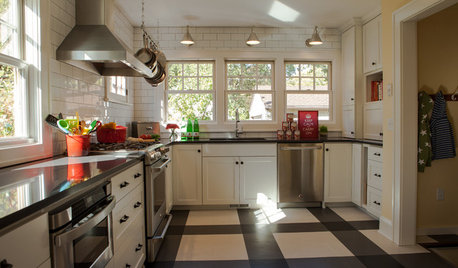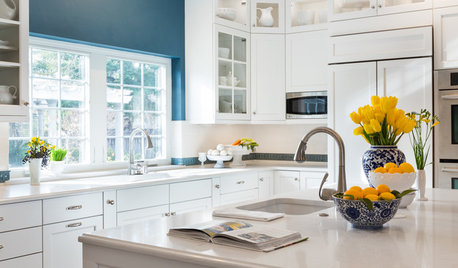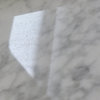Are cold spots normal in radiant floor heating?
hennen
12 years ago
Featured Answer
Sort by:Oldest
Comments (23)
davidro1
12 years agoweedyacres
12 years agoRelated Discussions
Is radiant floor heat adequate as the only heat source?
Comments (7)Thanks for all the input; it's been really helpful. Shanghaimom, I did a 'step test' with a 12x12 marble sample I had on hand, and you're right; it is so much colder than the tile. That has convinced me to install floor heat, even if it's only a secondary source. I had no idea that hydronic toekick heaters existed; the quotes I got all mentioned 'electric fan toekick heaters', and I didn't want to go that route. When discussing with my contractor last evening, he was very supportive of the hydronic solution; now I just have to make sure that the unit will fit under the 'door' side of my vanity (will need to access it for service, so it really shouldn't creep into the drawer side of the cabinet.) Fingers crossed! Mongo, thanks! I'll do my homework on the BTU calculations; thanks for pointing out what to look for. Lynneblack, thanks for the vent/fan/light combo idea. I've read on the boards that the Panasonic is a great unit, but one of the two items I'm keeping from the current bathroom is my Nutone melon vent fan/dimmable light....See MoreVents blow cold air at end of heat cycle, normal?
Comments (6)"We don't have a furnace, we have a boiler." You saved me the trouble sue of explaining that! OK, what you have is an aqua stat that controls the fan in your air handler. When the t stat calls for heat either a pump comes on or a zone valve opens downstairs and allows 180 degree water to flow through the coil in your air handler. On the hot water pipe that leaves the coil should be a thermostat attached to this pipe. When it senses the water is hot enough going back to the boiler it brings on the blower. That thermostat, known as an aqua stat should be set at 140 degrees. Thats the temperature the fan comes on. The fan off setting is usually 100 degrees. Yours is probably set to low. Check the aquastat settings, there may be 2 settings (on and off) or there may be just 1 and a differential. If its that one set it at 140 with a 40 degree differential. The nice thing about a system like yours is you can fine tune them. If 100 degrees feels to cool you can tweek it up a few degrees to find something more to your liking. You don't have to worry about overheating the equipment. Just don't adjust the two settings to close together or else the blower my cycle on and off to ofter before the t room stat is satisfied...See MoreIs it smart to use radiant heating on 1-floor and heat pump on 2nd?
Comments (14)If the house is designed to current IECC energy codes or better, the 1st level radiant could probably handle most of the home's heating loads including 2nd level. If upfront costs and operating costs are important, you may want to reconsider radiant floors and propane as main energy source. Here is [recent thread on propane[(https://www.houzz.com/discussions/energy-star-most-efficient-2019-boilers-help-reading-the-stats-dsvw-vd~5649781?n=36) boilers. To summarize, propane is the most expensive common fuel. It would cost less to heat your home using electricity, as long as you choose high efficiency heat pump options. Cold climate heat pumps are available for your climate so choose a contractor who is comfortable with them and follow their guidance on any needed backup. Tough to beat woodstove with frequent power outages. Radiant only provides heating so it's a tougher choice if the upgrade costs are worthwhile in your climate. Cold climate heat pumps can satisfy heating needs with generally less upfront costs. Ductless heat pumps are packaged systems that are easy to install. Providing sweat equity for radiant floors will be needed to compete in upfront costs. Tubing, manifolds, pumps, appliances, controls, pipes, all done in custom snowflake fashion. Giant propane tank, piped fos$il fuels into house, combustion exhaust to expel, hopefully not backdraft. Most people choosing radiant are going off experience based on inefficient homes. Building to current codes changes the comfort dynamic and some find radiant less comfortable due to thermostat delay response. Radiant floors rarely make economic sense for efficient homes....See MoreHot spots with hydronic radiant floor heat.
Comments (5)I have a Watts temperature mixing valve, with a temp gauge on it, I'll roll it back and see how that works. It's just one small spot that's hot, the rest of the floor is fine barefoot. I was just curious why it might be a recent issue.. From one of the radiant sites: Typical Radiant Heat Floor System Operating Temperatures Typical radiant floor systems operate at 85 - 125 °F water temperature entering the tubing, and put the floor surface temperature about 5 degrees above the room thermostat set temperature. Similarly other sources such as the Oregon state energy conservation department gives the typical operating temperature range for radiant heating systems at 85-140 °F (30-60C) though we agree that 140 deg.F. is a bit higher than suggested by other sources. A radiant heat system manufacturer, Radiant Floor Company, opines that 120 to 135 deg F is "ideal" and most sources we have found discuss typical radiant heat operating temperatures in the 115-135 degree range. Where PEX tubing is used for radiant-heat under-floor tubing, 125 to 130 °F is typical operating temperature used for water entering the tubing. Most radiant floor heating systems we've examined run at around 115F water temperature entering the tubing of the radiant section, and you'll see by the temperature gauge at the top of this article that 115 °F was the factory default set temperature on the control of an electric radiant heat boiler we installed....See Morehennen
12 years agodavidro1
12 years agoweedyacres
12 years agogr8daygw
12 years agorewok
12 years agoMongoCT
12 years agoEngineerChic
12 years agoFalcon Alaska
8 years agolast modified: 8 years agohennen
8 years agoweedyacres
8 years agoMongoCT
8 years agolast modified: 8 years agoFalcon Alaska
8 years agohennen
8 years agoMongoCT
8 years agolast modified: 8 years agoFalcon Alaska
8 years agohennen
8 years agoFalcon Alaska
8 years agoVertise
8 years agolast modified: 8 years agogr8daygw
7 years agoweedyacres
7 years ago
Related Stories

FLOORSIs Radiant Heating or Cooling Right for You?
Questions to ask before you go for one of these temperature systems in your floors or walls (yes, walls)
Full Story
GREAT HOME PROJECTSHow to Add a Radiant Heat System
Enjoy comfy, consistent temperatures and maybe even energy savings with hydronic heating and cooling
Full Story
FLOORSFloors Warm Up to Radiant Heat
Toasty toes and money saved are just two benefits of radiant heat under your concrete, wood or tile floors
Full Story
FLOORSWhat to Ask When Considering Heated Floors
These questions can help you decide if radiant floor heating is right for you — and what your options are
Full Story
BATHROOM DESIGNWarm Up Your Bathroom With Heated Floors
If your bathroom floor is leaving you cold, try warming up to an electric heating system
Full Story
ARCHITECTURE15 Smart Design Choices for Cold Climates
Keep your home safe and comfortable in winter by choosing the right home features and systems
Full Story
KITCHEN DESIGNKitchen of the Week: Drab and Dysfunctional to Radiant in Minnesota
Clunky storage and lackluster floors get nixed in favor of open shelves, plaid vinyl and an effective kitchen work triangle
Full Story
LIFEHouzz Call: How Are You Handling the Record-Breaking Cold?
Share your tales, strategies and photos for everything polar vortex
Full Story
GREEN BUILDINGHouzz Tour: Passive House in Vermont Slashes Heating Bills
Its ecofriendly, low-maintenance design leaves a family with more time to relax and enjoy the weekend home
Full Story
SELLING YOUR HOUSE9 Tips for Living a (Semi-)Normal Life While Your Home Is Being Shown
Preparation, routine and treats help you make the house you’re selling presentable at a moment’s notice
Full StorySponsored
Central Ohio's Trusted Home Remodeler Specializing in Kitchens & Baths






Falcon Alaska